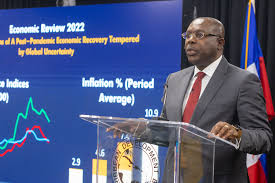
Caribbean Development Bank (CDB) Forecasts Economic Growth of 4.6% for 202
The Caribbean Development Bank (CDB) has projected a positive outlook for the Caribbean economy, forecasting a growth rate of 4.6% for 2025. This projection comes at a time when the region continues to recover from the global disruptions caused by the COVID-19 pandemic
and the subsequent economic slowdown. The CDB’s forecast offers hope for a robust recovery, driven by multiple factors, including the resumption of global trade, an uptick in tourism, and ongoing investments in infrastructure. This article explores the key drivers behind this projected growth and the implications for the Caribbean region.
Key Drivers of Caribbean Economic Growth in 2025
Several factors are expected to contribute to the Caribbean’s economic growth in 2025, and understanding these drivers is essential for grasping the CDB’s optimistic forecast. First and foremost, the resurgence of the tourism sector plays a pivotal role. With global travel
restrictions easing and the Caribbean remaining a favored destination for international travelers, countries in the region have experienced a strong rebound in visitor
arrivals. Tourism is a critical sector for many Caribbean economies, directly contributing to GDP, employment, and foreign exchange earnings. As travel demand continues to recover, this is expected to stimulate the economies of popular tourist destinations, including the Bahamas, Jamaica, Barbados, and the Dominican Republic.
Beyond tourism, infrastructure development is another crucial component of the region’s economic growth. The CDB has emphasized the importance of investing in infrastructure to support sustainable development. Countries
such as Jamaica, Trinidad and Tobago, and others have already embarked on large-scale infrastructure projects aimed at improving transportation networks, energy generation, and telecommunications. These investments are expected to not only create jobs but also
enhance the long-term productivity and competitiveness of Caribbean economies. Furthermore, the ongoing push for renewable energy projects throughout the region is expected to bolster economic growth by improving energy efficiency and reducing reliance on imported fossil fuels.
Trade and investment are also projected to be key contributors to the Caribbean’s recovery in 2025. The CDB has highlighted that regional integration through the Caribbean Community (CARICOM) and increased foreign direct
investment (FDI) will continue to fuel economic growth. As global supply chains recover and trade barriers ease, Caribbean countries are poised to benefit from stronger export growth, particularly in sectors like agriculture, manufacturing, and services. Additionally,
international investors are increasingly looking to the Caribbean as a stable region for investment, spurred by relatively low levels of political instability and strong ties with global markets, especially in North America and Europe.
Moreover, the region’s efforts to diversify its economy beyond traditional industries are beginning to pay off. The tech and digital economy in particular is growing, with countries like Barbados and Trinidad and Tobago leading the way in establishing
themselves as hubs for innovation and fintech. As the Caribbean seeks to become less reliant on tourism and natural resources, expanding sectors like technology and services could contribute significantly to the region’s growth in 2025 and beyond
Challenges and Risks to Growth in 2025
While the CDB’s 4.6% growth forecast for 2025 is promising, it is important to recognize that there are several challenges and risks that could hinder the region’s economic performance. These risks stem from both external and internal factors, which require careful management.
One of the most significant external risks is the global economic environment. The Caribbean is highly vulnerable to global economic fluctuations, including changes in commodity prices, shifts in demand for exports, and
volatility in financial markets. If the global economy slows down or if key trading partners experience economic downturns, the Caribbean could see a reduction in demand for its exports and a slowdown in investment flows. Additionally, natural disasters such as
hurricanes, which frequently affect the region, pose a persistent threat to economic stability. The 2020s have already seen some devastating storms, and future extreme weather events could lead to costly rebuilding efforts, further straining already fragile economies.
Internally, many Caribbean nations face the ongoing challenge of high public debt, which limits the ability to invest in crucial social and economic infrastructure. Public debt remains a significant concern, as many countries in the region carry large debt burdens due to
borrowing during previous economic crises. These countries may face difficult decisions about whether to prioritize debt servicing or invest in critical areas such as education, healthcare, and infrastructure.
Another challenge that could affect growth is the region’s reliance on a few key industries, especially tourism. While tourism is expected to drive growth in the short term, its over-reliance can make the Caribbean vulnerable to external
shocks, such as global health crises or economic recessions. Diversifying economies further, as mentioned earlier, is a long-term solution, but achieving diversification will require continued effort, innovation, and capital investment.
Finally, political and social stability will play an important role in determining whether the Caribbean can achieve sustained growth.
Political instability or social unrest in any part of the region could deter foreign investment and undermine consumer confidence, ultimately hindering economic progress.
Conclusion: A Mixed Outlook with Optimism
The Caribbean Development Bank’s forecast of 4.6% economic growth in 2025 brings optimism for the region’s recovery and future prospects. With key drivers such as a rebound in tourism, infrastructure development, regional
integration, and sectoral diversification, there are several factors that could push Caribbean economies forward in the coming years. However, challenges such as external economic volatility, natural disasters, and high public debt remain significant obstacles that must be
navigated carefully. If the region can address these risks while capitalizing on its growth drivers, it has the potential to not only recover but also build a more resilient and diversified economy for the future.
Leave a Reply